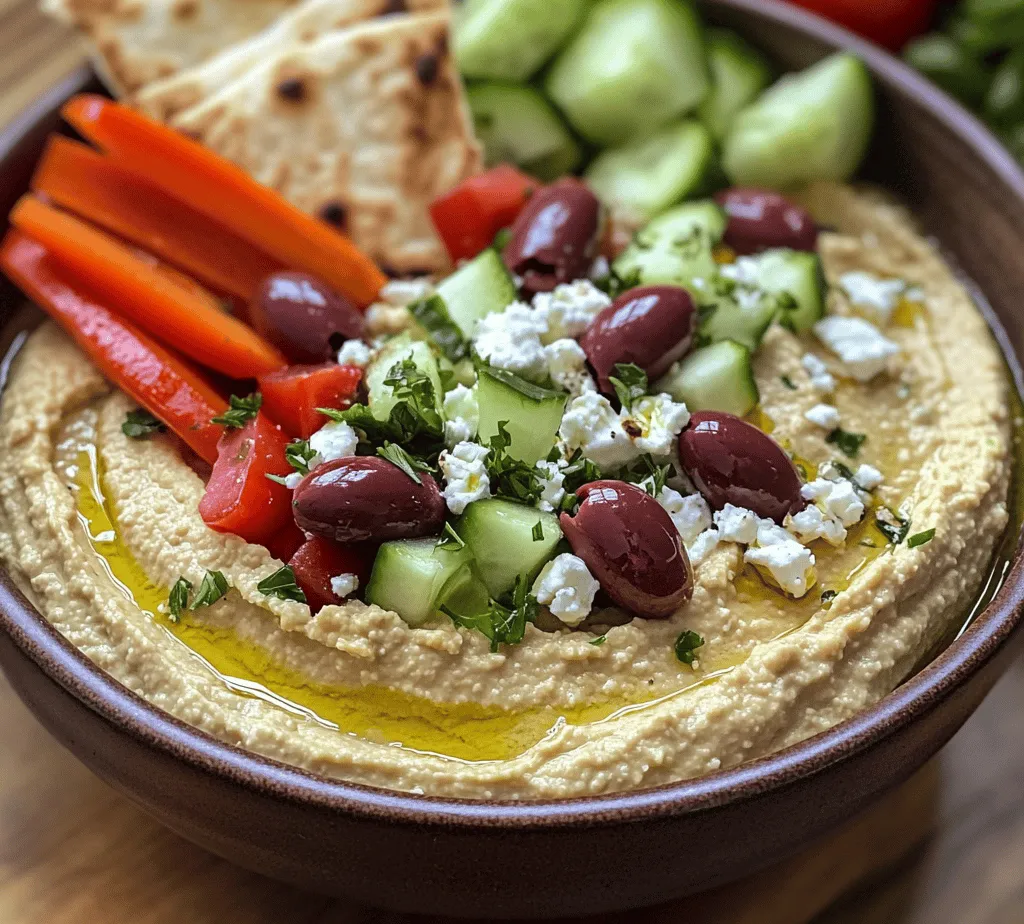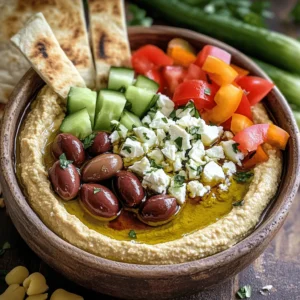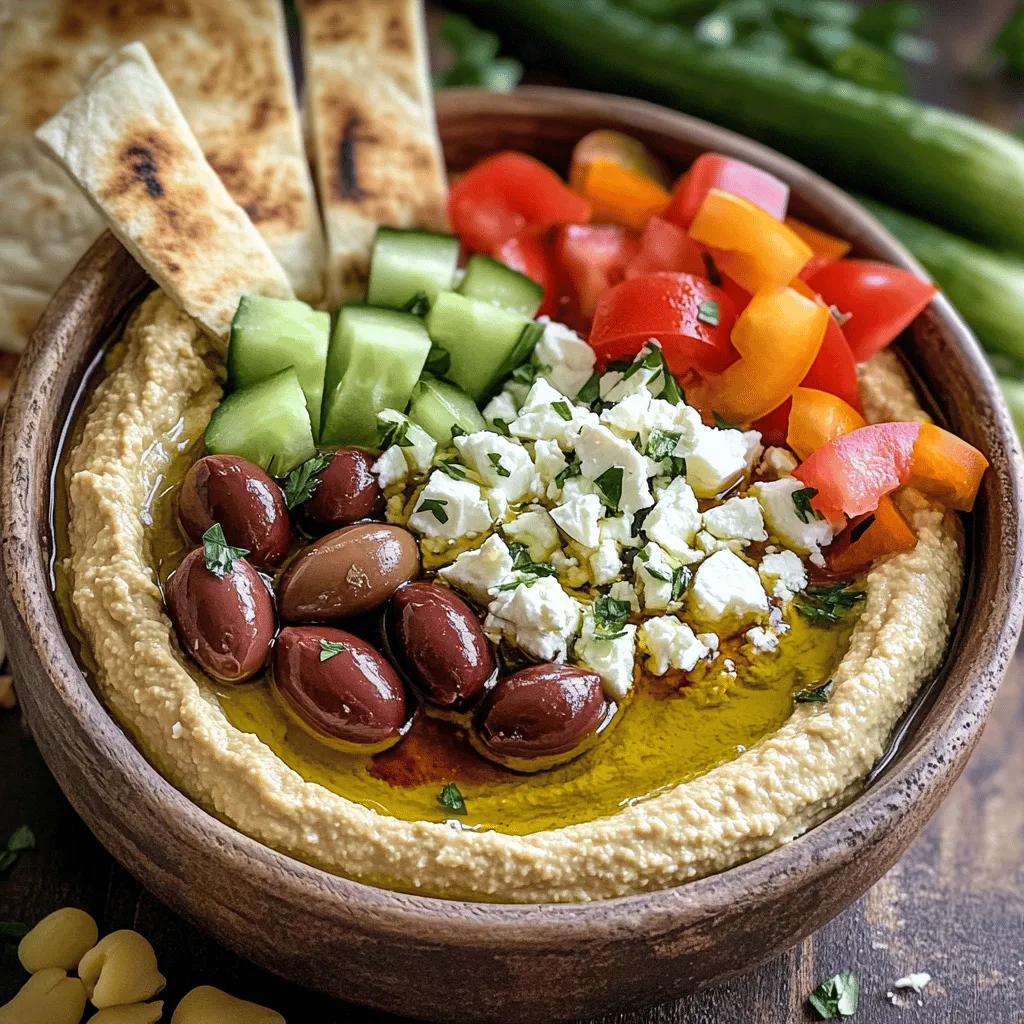Introduction to Greek Style Loaded Hummus
Hummus has long been celebrated as one of the quintessential dips of Mediterranean cuisine. With its creamy texture and rich flavor, this chickpea-based spread has transcended cultural boundaries, becoming a beloved staple in households and restaurants across the globe. However, beyond the classic version, there is a vibrant and exciting variation known as Greek Style Loaded Hummus. This delightful dish takes the traditional hummus recipe and elevates it with an array of fresh, vibrant toppings and flavors inspired by Greek culinary traditions.
Greek Style Loaded Hummus stands out not only for its irresistible taste but also for its unique blend of textures. Imagine a velvety base of hummus topped with a medley of colorful ingredients including fresh vegetables, herbs, tangy feta cheese, and briny Kalamata olives. This dish is a feast for the eyes and the palate, making it the perfect centerpiece for gatherings, parties, or a simple snack.
What makes this recipe particularly appealing is its wealth of health benefits. Chickpeas, the primary ingredient, are packed with protein, fiber, and essential vitamins and minerals, making hummus a nutritious option for any meal. Additionally, the versatility of Greek Style Loaded Hummus means it can be enjoyed in countless ways—served with pita chips, fresh vegetables, or even as a spread on sandwiches. Plus, the ease of preparation makes it accessible to cooks of all skill levels, whether you’re a seasoned chef or a kitchen novice.
Understanding Hummus: A Mediterranean Staple
To appreciate Greek Style Loaded Hummus fully, it is essential to delve into the historical background of hummus itself. Hummus is believed to have originated in the Middle East, with roots that extend back centuries. The earliest known recipes date back to the 13th century, though the dish has likely been enjoyed in various forms long before that. Over time, hummus has evolved, with each culture adding its unique twist, contributing to the diverse range of flavors and styles we see today.
Chickpeas and tahini are the core components of traditional hummus, each bringing its own nutritional benefits. Chickpeas, also known as garbanzo beans, are a powerhouse of nutrition. They are high in protein and fiber, which makes them an excellent choice for plant-based diets. Additionally, they are rich in vitamins like B6, folate, and minerals such as iron, magnesium, and phosphorus. Tahini, a paste made from ground sesame seeds, adds not only a creamy texture but also a nutty flavor and healthy fats. It is also a source of calcium and antioxidants, making it a nutritious addition to the dish.
As hummus has traveled across the Mediterranean and beyond, various cultures have adopted and adapted the recipe, leading to an array of enticing variations. From spicy harissa-infused hummus in North Africa to roasted red pepper versions found in the Levant, there is no shortage of creativity when it comes to this beloved dip. The Greek Style Loaded Hummus takes inspiration from Mediterranean flavors and ingredients, making it a perfect example of how hummus can reflect regional tastes.
Ingredients for Greek Style Loaded Hummus
Creating the perfect Greek Style Loaded Hummus begins with understanding the key ingredients that contribute to its deliciousness and nutritional profile. Here’s a breakdown of the essential components that make this dish stand out:
1. Chickpeas: As the base of the hummus, chickpeas are crucial not only for flavor but also for their health benefits. Rich in protein and fiber, they help promote satiety and digestive health. When preparing hummus, you can use canned chickpeas for convenience or soak and cook dried chickpeas for an even fresher taste.
2. Tahini: The quality of tahini can significantly impact the flavor of your hummus. Opt for a high-quality tahini made from roasted sesame seeds for a nutty and creamy result. Tahini is not only delicious but also provides healthy fats and a dose of calcium.
3. Olive Oil: A cornerstone of Mediterranean cuisine, olive oil adds a rich flavor and creaminess to the hummus. Beyond taste, it is renowned for its health benefits, including heart-healthy monounsaturated fats and antioxidants. Drizzling a good quality extra virgin olive oil over the finished dish enhances both flavor and presentation.
4. Fresh Herbs and Vegetables: Fresh ingredients like parsley, dill, or mint can elevate the hummus with vibrant flavors and aromas. Additionally, vegetables such as cucumbers or bell peppers add crunch and freshness, making the dish more appealing and nutritious.
5. Greek Yogurt: For an extra layer of creaminess and richness, Greek yogurt is incorporated into the hummus. It not only contributes to the texture but also adds probiotics, which can be beneficial for gut health.
6. Kalamata Olives and Feta Cheese: These traditional Greek elements bring a briny, savory depth to the hummus. Kalamata olives add a burst of flavor, while crumbled feta cheese provides a creamy, tangy contrast that complements the other ingredients beautifully.
Incorporating these ingredients thoughtfully will ensure your Greek Style Loaded Hummus is a delightful and healthy dish that captures the essence of Mediterranean cuisine.
Preparation Steps for Greek Style Loaded Hummus
Now that we’ve discussed the ingredients, let’s dive into the preparation steps for creating your Greek Style Loaded Hummus. This straightforward process will guide you through making a flavorful and creamy dip that will impress your friends and family.
1. Prepare the Chickpeas: If using dried chickpeas, soak them overnight in plenty of water. The next day, drain and rinse them before cooking. Boil the chickpeas in fresh water for about 1 to 1.5 hours until they are tender. If using canned chickpeas, simply drain and rinse them under cold water to remove excess sodium.
2. Blend the Base: In a food processor, combine the prepared chickpeas, tahini, olive oil, and Greek yogurt. Add a pinch of salt and a splash of lemon juice for brightness. Blend the mixture until smooth, scraping down the sides as necessary. If the mixture appears too thick, add water a tablespoon at a time until you reach your desired consistency. The goal is to achieve a creamy and velvety texture.
3. Adjust for Flavor: Taste the hummus and adjust the seasoning as needed. You may want to add more lemon juice, salt, or even garlic depending on your flavor preferences. The beauty of this recipe lies in its adaptability—feel free to make it your own!
4. Layering for Presentation: Once the hummus is blended to perfection, transfer it to a serving dish. To create an inviting presentation, use the back of a spoon to create a swirl in the center of the hummus. Drizzle additional olive oil over the top and sprinkle with freshly chopped herbs, crumbled feta cheese, and sliced Kalamata olives. You can also add diced cucumbers or cherry tomatoes for extra color and crunch.
5. Serve and Enjoy: Your Greek Style Loaded Hummus is now ready to be enjoyed! Serve it with warm pita bread, pita chips, or an assortment of fresh vegetables for dipping. This dip not only tastes amazing but also reflects the freshness and vibrancy of Mediterranean cuisine.
With these steps, you can create a delicious and visually appealing Greek Style Loaded Hummus that will become a staple in your recipe repertoire. The combination of flavors and textures will undoubtedly impress everyone who tries it, making it a perfect addition to any gathering or a delightful treat for yourself.

Incorporating Toppings for Added Texture and Taste
When it comes to Greek Style Loaded Hummus, the toppings can elevate your dish from a simple dip to a culinary masterpiece. Start with a base of smooth and creamy hummus, then let your creativity run wild with an assortment of toppings that not only enhance the flavor but also add delightful textures. Here are some fantastic options to consider:
1. Fresh Vegetables: Dice colorful bell peppers, cucumbers, and radishes for a crisp, refreshing bite. These vegetables not only add a vibrant visual appeal but provide crunch that complements the creamy base of the hummus.
2. Herbs: Fresh herbs can transform your dish. Consider finely chopped parsley, mint, or dill to add a fragrant aroma and a burst of flavor. A sprinkle of za’atar, a Middle Eastern spice blend, can also add a unique twist.
3. Olives: Kalamata or green olives provide a briny contrast that pairs beautifully with the creaminess of the hummus. Slice them or leave them whole for a pop of flavor.
4. Feta Cheese: Crumble some feta cheese over the top for a salty, tangy addition that enhances the Mediterranean essence of the dish.
5. Nuts and Seeds: Toasted pine nuts or sesame seeds can add a delightful crunch. They also introduce healthy fats and additional nutrients.
6. Chili Oil or Paprika: Drizzle some chili oil for a spicy kick or sprinkle smoked paprika for a hint of warmth and depth. This not only enhances the flavor but also adds a beautiful color contrast.
7. Roasted Red Peppers: Add sweet roasted red peppers for a smoky flavor that pairs beautifully with the other toppings.
By mixing and matching these toppings, you can create a Greek Style Loaded Hummus that is both visually stunning and deliciously satisfying.
Tips for Ensuring the Best Results During Preparation
Achieving the perfect Greek Style Loaded Hummus is all about the details. Here are some essential tips to ensure that your hummus turns out creamy, flavorful, and irresistible:
1. Use Quality Ingredients: Start with high-quality tahini and extra virgin olive oil. The flavor of these ingredients is crucial to the overall taste of your hummus.
2. Soak and Cook Chickpeas Properly: If using dried chickpeas, soak them overnight and cook them until they are tender. This will ensure that your hummus is smooth and not gritty. Canned chickpeas are convenient, but rinsing them before use helps to remove excess sodium and improve flavor.
3. Blend Thoroughly: When blending the hummus, give it enough time to ensure it’s completely smooth. Consider using a food processor for the best results, and scrape down the sides as needed.
4. Adjust Consistency: If your hummus is too thick, add a little water or reserved chickpea cooking liquid to achieve your desired consistency. Aim for a texture that is creamy and spreadable.
5. Taste as You Go: Adjust the seasoning gradually. Taste the hummus after adding lemon juice, garlic, and salt, and modify according to your preference.
6. Let It Rest: Allow your hummus to sit for at least 30 minutes after making it. This resting period allows the flavors to meld together beautifully.
7. Store Properly: If you have leftovers, store them in an airtight container in the refrigerator. Drizzle a little olive oil on top before sealing to maintain freshness.
Serving Suggestions and Pairings
Greek Style Loaded Hummus is not just a delicious dip; it can be a versatile centerpiece on your table. Here are some ideas for serving and pairing this delectable dish:
1. Traditional Accompaniments: Serve your hummus with warm pita bread or crisp pita chips. The soft texture of pita complements the creamy hummus, making it easy to scoop. You can also include an assortment of fresh vegetable sticks like carrots, celery, cucumbers, and bell peppers.
2. Creative Serving Options: Use Greek Style Loaded Hummus as a spread on sandwiches or wraps, adding a burst of flavor that elevates simple ingredients. It can also serve as a dip for grilled meats or seafood, making it a versatile addition to your meals.
3. Mezze Platter: Create a mezze platter by arranging your loaded hummus alongside other Mediterranean favorites like baba ganoush, tzatziki, stuffed grape leaves, and assorted olives. This makes for an impressive appetizer spread that encourages sharing and interaction.
4. Beverage Pairings: Pair your hummus with refreshing beverages that complement its flavors. Light wines such as Sauvignon Blanc or a crisp rosé work beautifully. For a non-alcoholic option, consider serving sparkling water with a twist of lemon, or a refreshing mint lemonade.
Health Benefits of Greek Style Loaded Hummus
Greek Style Loaded Hummus is not only delicious but also packed with health benefits from its wholesome ingredients:
1. High Protein Content: Chickpeas are a fantastic source of plant-based protein. Combined with yogurt, this hummus provides a significant protein boost, making it a satisfying option for vegetarians and vegans alike.
2. Healthy Fats: The olive oil and tahini used in the recipe offer healthy monounsaturated fats, which are known to promote heart health and reduce inflammation.
3. Vitamins and Minerals: Fresh vegetables and herbs provide essential vitamins and minerals. For instance, bell peppers are high in vitamin C, while parsley is rich in antioxidants. The dish is a great way to incorporate more vegetables into your diet.
4. Dietary Versatility: Greek Style Loaded Hummus fits well into various dietary lifestyles, including vegan, vegetarian, and Mediterranean diets. Its wholesome ingredients align with health-conscious eating patterns, making it a great choice for a balanced diet.
Cultural Significance of Hummus in Greek Cuisine
Hummus is more than just a dish; it embodies the essence of Greek culinary traditions and social gatherings:
1. Culinary Tradition: Hummus has deep roots in Mediterranean cuisine, with variations found across the region. In Greece, it is often enjoyed as part of a meze—a collection of small dishes shared among friends and family, highlighting the communal nature of dining.
2. Social Gatherings: Hummus serves as a centerpiece during celebrations and social gatherings, symbolizing hospitality and togetherness. It invites people to gather around the table, share stories, and enjoy each other’s company.
3. Communal Spirit: The act of dipping, sharing, and savoring this dish reflects the communal spirit of Mediterranean dining. It encourages a slower pace, fostering connections between those who share the meal.
Conclusion: Embracing Greek Style Loaded Hummus in Your Kitchen
Greek Style Loaded Hummus is a celebration of flavors, textures, and cultural heritage that invites you to explore the richness of Greek cuisine. Its versatility makes it an ideal dish for any occasion, whether you are hosting a gathering or enjoying a quiet evening at home. By preparing this dish, you not only indulge in a delicious treat but also embrace the joy of sharing food with loved ones.
As you bring this recipe into your kitchen, take the time to experiment with various toppings and pairings that reflect your taste. Embrace the health benefits that come from the wholesome ingredients, and appreciate the cultural significance of hummus within the Mediterranean tradition.
So, gather your ingredients, invite your friends, and embark on a culinary journey that celebrates the vibrant flavors of Greek cuisine through the delightful experience of making and sharing Greek Style Loaded Hummus. Enjoy the process and savor the connections it fosters, making every bite a moment to remember.



